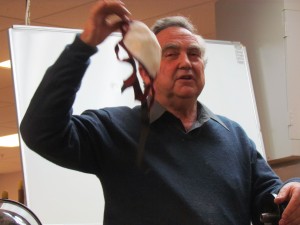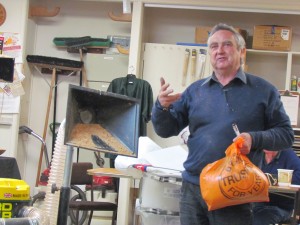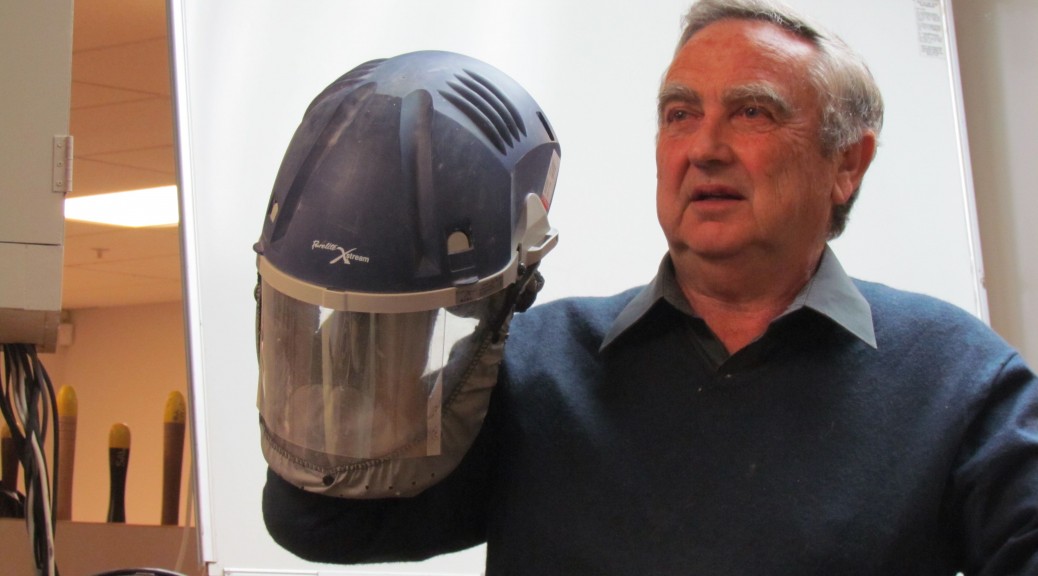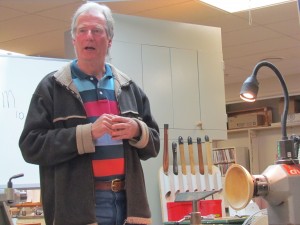Club Meeting: 9th September 2015
Report by: Kevin Reeve
A synopsis of the general theme of the two main topics covered by the presenters, Warwick Day focused on dust protection for the “turner” whilst John Whitmore would later follow on illustrating how to eliminate dust totally from the environment by wet sanding.
The presentation was started off by Warwick, who identified specific areas to minimise dust, affecting the person.
Design
Dust potential starts well before you even turn the lathe on, so deciding what you are turning has an impact of the volume of dust created. As an example, thought should be given to whether you are turning end grain, which creates a lot more dust, or cross grain, which in general has less dust.
Wood Type
With any wood turned, shavings and dust are the resultant effect.
Those that are more sensitive to dust should consider using a harder wood to turn, such as walnut or Black Marie.
Some of the softer woods do create more dust, so this needs to be another consideration for minimising the effect of dust on the person, and your work area.
An example, demolition rimu, where the fibres in the wood exhibited some rotting, created a lot more dust.
In general, the lighter the wood, the more dust there will be Warwick says.
A question was asked from the floor about spalting, and the risks.
Spalting is any discolouration of wood caused by fungi. Research has identified that it can be found in a living tree, a tree under stress or a dead tree.
The area for concern for the turner are the fungi pores can have a detrimental effect on the lungs, as well as your skin. Coupled with this there needs to be a consideration about the types of wood you are using which may escalate the risks.
This lead to a discussion about toxic wood.
The beginner guide does cover toxic woods, and will not be expanded on this in article, as it is a very specific field, and a topic which can be covered on its’ own merits.
Tools
How sharp are your tools?
The question was put to the audience to get turners thinking about the tool they are using, and their condition.
The turner should not become lax in their tool maintenance, and at every opportunity where there is some trepidation about the quality of their tool sharpness, it should be remedied.
The sharper the tool, the less dust.
Levels of Dust Protection
Masks
There are a variety of dusk masks of the market, both in quality and specific use. Careful consideration must be given to both how they fit the user, and the level of dust protection they provide.
Dust masks have various ratings for example P1 P2 and P3. If the reader requires an in-depth description of the mask ratings, they can go to:
http://www.business.govt.nz/worksafe
There is a good amount of information on this site to assist the turner.

Full face dust protection
Warwick demonstrated the AC400 full face enclosed dust and face mask system. The advantage of this system is the battery is enclosed in the head unit and can provide up to 8 hours plus service.
The unit describes as providing full air filtration.
The face shield is rated at 90 kilo Newton’s. As a comparison, the clubs shields are rated at 70 KN
Vacuums cleaners, Air hose blowers, and Fans
Warwick completed the first part of his presentation of 3 other devices. His number one tool in the shed was a vacuum cleaner to clear and reduce dust.
Secondly, he pointed out the disadvantage of using an air hose to blow dust everywhere, the more dust you blow around the more dust you are working in.
Warwick touched on the use of free standing fans, and the benefits and blowing dust away from the area you working in.
These can be beneficial combined with a good extraction system, and perhaps fresh air.
This lead on to a discussion from the floor that dust in the workshop can present an inherent risk of being highly combustible if not attended to.
Hand and power sanding tools
Warwick exhibited the different types of power sand tools.
His preference is the inertia type sander with the lathe running at a low speed.
The advantage he suggested was there was less heat created through rotation from two seperate electrical power sources.
The next part of the presentation was from John Whitmore
John’s suggested there should be no dust at all.
Speaking from experience, John turns inside his own home, and albeit a few wood shavings in the house, he has attempted to eliminate all dust in the environment.
John commences his presentation by offering free dusk masks to everyone.
John introduced his presentation by saying humans have lived with dust for “millennia” and because of our ability to get rid of dust through lungs and their biological efficiency.
He went on to say that because of the industrial revolution, our natural ability to do this has been nullified due to exposure to external chemical variants that we would not have been exposed to.
There was some brief discussion around asbestosis, its’ origin’s and use.
He presented a wet sanding solution using 100 grit sand paper and Ondina oil which is produced by shell petroleum. (Research can be done by looking up the product)
There was discussion about the limitations with finishing whilst using this product.
The merits using this way of sanding were presented were twofold:
Eliminating dust by creating a slurry effect on the Astra paper
It cools the wood
A comment from the floor suggested any type of small brush will remove the slurry and one can perhaps use WD40.

The next part of the presentation was again from Warwick about machinery and dust extraction using various machines from manufacturers, but due to the extended time taken with the meeting it is an area that should be looked at again.
A big thanks to Warwick and John. An extremely informative presentation about dust and how it can affect turners, and something we should all consider.

